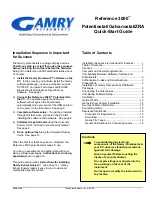
QuantAsylum QA401 User
’s
Manual
Page
33
The QA401 supports 5 basic windowing functions as shown above:
Rect
This is also commonly called Rectangular, boxcar, uniform, or no windowing. This is most
useful when you can precisely ensure you have collected an integer number of cycles of
the waveform. When you can do this, you can then apply no windowing and introduce the
minimum amount of distortion to your displayed data. This is the reason you see ADC data
sheets measuring odd frequencies at odd sample rates. They are striving to capture an
integer number of cycles so that they can apply no windowing. Under these conditions,
the Rect can deliver excellent results for ripple, dynamic range and resolution.
Hann
The Hanning window provides a great balance between ripple, dynamic range and
resolution for all sorts of signals. It does have about 0.6dB of ripple. If amplitude accuracy
is important, then consider Flat Top.
Bartlett The Bartlett window is similar to Hann, with worse leakage and frequency resolution.
Generally, unless a procedur
e calls specifically for this window, you’ll want to use Hanning.
Hamm
The Hamming window is similar to Hann, but with a bit more spectral leakage. Generally,
unless a test procedure calls for this windows specifically, you’ll want to use Hanning.
Flat
Top
For accurate amplitude measurements, the Flat Top is the best choice. On the QA401,
you’ll generally see less than 0.05 dB of amplitude variation using this
selection.
Measurement Types
Definitions
The QA401 makes basic audio measurements quickly, can perform more advanced sweep-type
measurements and can permit 3
rd
party applications to control the QA401 for even more sophisticated
measurements.
Basic audio measurements usually involve terms such as SNR, THD and SINAD. But often it can be
confusing to remember what each measurement refers to precisely. The purpose of this section is to
clarify the meanings as incorporated in the QA401. The Analog Devices app note MT003
1
is an excellent
write-up on the topic.
Total Power is defined as the RMS of the spectrum bounded by the user-set Measurement Start and
Measurement Stop parameters.
1
Kester, Walt,
Understand SINAD, ENOB, SNR, THD, THD + N, and SFDR so You Don't Get Lost in the Noise Floor
,
Analog Devices MT-003
Содержание QA401
Страница 70: ...QuantAsylum QA401 User s Manual Page 70...
















































